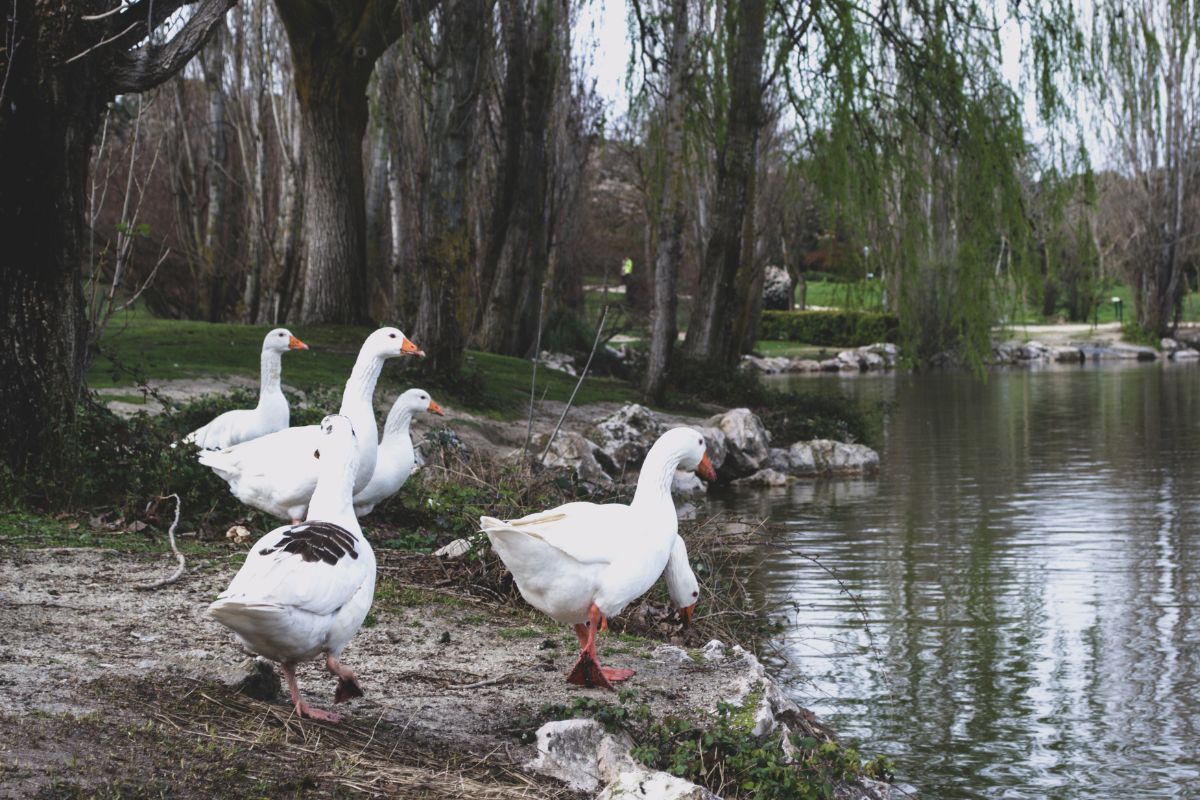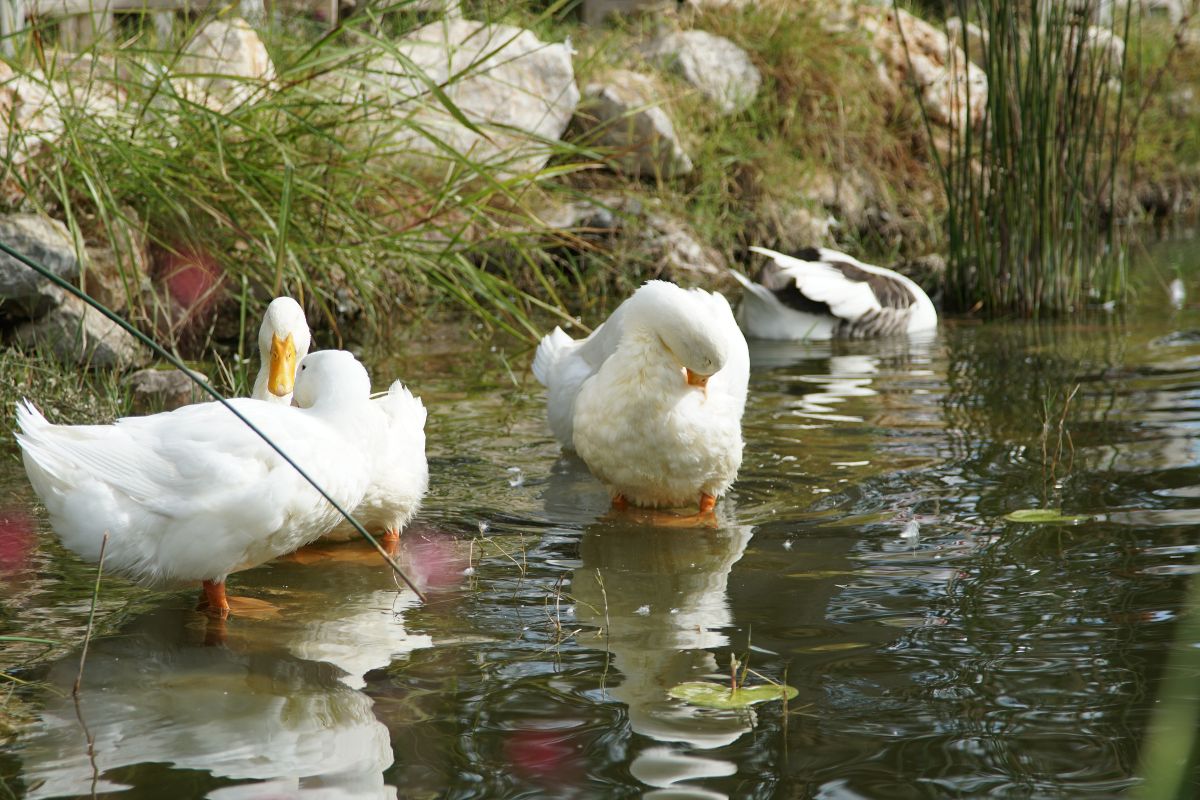Have you ever wondered about the behaviors of farm animals or various birds in the wild? If so, you must have thought about ducks and why they love to wag their tails.

Ducks are some of the most adorable and fun animals you’ll find in nature. So, why do ducks wag their tails? We will detail the top nine reasons why ducks shake their tail feathers.
Ready to learn all about it? Then keep reading!
Contents
To Show Excitement
Ducks can get excited about numerous things. When that happens, they may start wagging their tails. For example, if a duck just ate a good amount of food or drank something tasty, they get excited and starts shaking its tail feathers!
When ducks see a friend or even a human who feeds them, they become happy and start shaking their tails. Sometimes, stressful situations also lead ducks to wag their tails. But, generally, both excitement and happy moods make ducks display that behavior.
To Dry Off
You will find that ducks spend much of their time in a pond or lake. This is because they are waterfowl and love to go swimming. It’s also how they find food and fish to eat.
Further, ducks need to get wet for their preen glands, oil-producing glands found in many birds. These glands work to keep the duck’s feathers waterproof. The water is responsible for keeping these glands from drying out.
Even though getting wet is important, the duck does want to stay dry when out of the water. So you are likely to see ducks wag their tails to dry off whenever they get out of a pond or lake. They may also wag their tails to show how happy they are after swimming.
When Mating

During the breeding season, a female duck picks a male to mate with. However, before the females pick their mate, the male ducks have to woo the females with their behavior and looks.
Common mating behavior among males is wagging and shaking their tails. You are also likely to see the male duck flapping its wings, shaking its head, and preening when trying to woo a female for mating. Sometimes, you may also see female ducks wagging their tails when mating.
You will see these behaviors among ducks during mating season, which is during the spring and early summer.
To Communicate With Each Other
Sometimes, you may see a duck wagging its tail to communicate with other ducks. For instance, ducks communicate how happy and excited they are by shaking their tail feathers.
For ducks with owners or living on a farm, they will wag their tails to show their satisfaction and appreciation after having a drink or a large meal.
In addition, ducks may show off their feeling of accomplishment and communicate it by wagging their tails. At the end of the day, these birds use their body language to communicate with each other and humans.
When Walking or Waddling
Ducks have a silly way of walking in which they look like they’re waddling. Their clumsy walk includes some tail wagging. By wagging their tails, they can balance better when walking.
Ducks’ webbed feet and the position of their legs make it difficult for them to walk on land. Their bodies are designed for swimming well in water instead of walking on land.
For instance, you’ll see them taking short steps and swaying from side to side. By wagging their tails, they keep themselves from falling to either side.
To Self-Soothe

When ducks feel stressed or are on high alert, they tend to self-soothe and restore a sense of calm by wagging their tail feathers.
Whether the duck is stressed or undergoes intense physical activity, the fowl will wag its tail to calm itself. You may find ducks doing so after defending their nests or confronting a predator.
When Their Feathers Get Damaged
Ducks who wag their tail feathers too much may have a condition called “wet feather.” That might occur if the duck spends too much time in the water. Exposure to excess water can also occur if a duck gets stuck outdoors in a downpour.
In these cases, their feathers may not have a chance to dry off, and the tail feathers may no longer have a waterproof capability.
When They Get Sick
If you see your duck shaking its head, looking very tired, and wagging its tail, you should call the veterinarian. In these cases, a duck is often sick. To determine if your duck is feeling ill, check its preen gland.
The preen gland is right next to a duck’s tail. The duck is usually sick if the preen gland looks yellow or inflamed. That’s one of the reasons why the waterfowl may shake its tail feathers.
When Searching for Something

Normally, ducks spend their time looking out for predators or searching for food. Whenever they are on the lookout, ducks tend to shake their tails. You will likely see a duck wagging its tail while also tilting its head to get better visibility of its environment.
Frequently Asked Questions (FAQs) About Ducks and Their Behaviors
Below, you can learn the answers to the most common questions about ducks and behaviors like wagging their tails.
Do ducks shake their tails when they’re happy?
Ducks do generally shake their tails when they’re feeling good or are in a happy mood. A happy and excited duck will wag its tail feathers and flap its wings. Further, a happy waterfowl will often jump from one spot to another.
How can you tell if a duck is happy?
A happy duck will bob its head up and down. It will also quack in a high-pitched tone. When ducks get a drink of fresh water, eat a tasty snack, or enjoy a good swim in a lake, they may bob their head up and down for 15 minutes straight.
Do ducks remember humans?
You will hear from veterinarians, caretakers, and duck owners that ducks can remember human faces. For instance, when a duck recognizes its owner, it will start quacking and chatting up a storm while following its owner. Ducks also need some attention, so pet owners should talk and play with the fowl.
How do ducks give kisses?
Ducks do give their pet owners kisses by using their beaks to nibble people’s feet and hands. That often happens after a pet owner feeds a duck. Also, when ducks get excited, they show appreciation by giving kisses or nibbles.
Are ducks smart?
Yes! Ducks are highly intelligent creatures. Like dogs, they can understand commands, enjoy playing with toys, and like to play games. If they’re introduced to humans at an early age, they’re also very sociable with people.
Before You Go

Now you should understand why your pet duck wags its tail feathers. There are numerous reasons, so pay attention to any other signs that may indicate whether your duck is sick. But you’ll typically see your duck shaking its tail when it’s happy, so tail wagging is nothing to be alarmed about.
If you don’t have a pet duck, you can still go feed the ducks at the local pond and enjoy their adorable behaviors.
